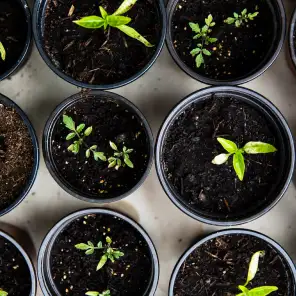Can’t stop eating that bag of chips until you’re licking the salt nestled in the corners of the empty package from your fingers? You’re not alone. And it’s not entirely your fault that the intended final handful of chips was not, indeed, your last for that snacking session. Many common snack foods have been expertly engineered to keep us addicted and almost constantly craving more of whatever falsely satisfying manufactured treat is in front of us.
“Humans have an inherited preference for energy-rich foods—like fats and sugars—and thus natural selection has predisposed us to foods high in sugar and fat,” explains Jennifer Kaplan, who taught the course, Introduction to Food Systems, at the Culinary Institute of America in St. Helena, California. “Food scientists know this and create ingredients that are far higher in fat and sugar than occur in nature. The most common such sugar is high-fructose corn syrup and is, therefore, intrinsically addictive.” In fact, foods that weren’t sweet previously, like pasta sauce, are now artificially sweetened to keep consumers craving the product, with sugar levels that can rival those found in packaged desserts.
High-fructose corn syrup (HFCS) is found in everything from ketchup and salad dressing to cereal and bread—foods that aren’t necessarily perceived as sweet—and sometimes even in “healthier” alternatives, like light beer. In 2019, Anheuser-Busch, the St. Louis-based brewer of Bud Light, highlighted the fact that the popular beer didn’t contain HFCS during a controversial Super Bowl commercial. The ad, which tried to push Bud Light as the more desirable light beer because of its lack of corn syrup (as opposed to its competitors), notably annoyed the Midwestern corn farmers, who are subsidized by the U.S. government to essentially keep pumping our processed foods with corn products.
These “multibillion-dollar government programs,” however, don’t reach the small farmers. “The largest 10 percent of farms receive nearly 80 percent of subsidies, primarily for commodity crops such as corn and soy—and entities downstream or upstream of the actual farmers earn most of the profits,” according to a 2023 opinion piece in the Kansas City Star.
High-Fructose Corn Syrup and Salts as Addictive as Drugs
So what’s so bad about HFCS, the ubiquitous ingredient so essential to the inner aisles of the American supermarket? A tablespoon of the super sweet stuff packs in roughly 53 calories, 14.4 grams of carbohydrates, and 5 grams of sugar, while an entire ear of corn has about 123 calories. It’s much easier to ingest extra, empty calories when they’re processed down to a sugary additive, which enhances the flavor of processed foods.
Lower-income households consume higher levels of ultra-processed food, given that it has a longer shelf life, is more accessible, and is strongly marketed. This leads to these households having more health issues like obesity and cardiometabolic disease.
As an ingredient, HFCS was shown in a 2013 study to be as addictive as drugs, like cocaine or heroin, with salt proven to have similarly addictive, opioid-like qualities. Australian neuroscientist Craig Smith has studied the effect of salt cravings in humans for years, concluding that eating excessive amounts of sodium makes people crave salt more, in his 2016 study published in the Proceedings of the National Academy of Sciences. The study suggests that opioid-blocking drugs may inhibit our salt cravings.
“These findings open the way for us to study this salt-seeking circuit in humans using magnetic resonance imaging and other techniques, to then develop targeted drugs to inhibit salt craving and promote more healthy dietary choices,” said Smith, according to a November 2016 article in Cosmos magazine. “If processed food producers are slow to respond to the need to reduce salt in their products, this could be another way to lower deaths associated with high salt intake.”
Even if a particular food isn’t overly salty, it may be sneaked into packaged food more rampantly than expected. “In most cases, salt is used as a preservative to give food extended shelf life and keep food safe,” explains Nia Rennix, a clinical nutritionist who specializes in weight loss and blood sugar regulation. Salt can also be used to enhance a food’s color (such as making the crust of bread a more appealing golden brown), as well as a flavor enhancer in foods you may not associate with saltiness, like ketchup or bread.
You may not be tasting the salt in your mall pretzel or packaged condiments, but salt as an ingredient is keeping you hooked. “Salt is extremely addictive, just as much as sugar. The more you consume salt, the more you crave it, and manufacturers realize this,” says Rennix. “They continue to add salt to foods because they want you to continue to purchase [their products]. It doesn’t matter if the salt is white, pink, sea salt, or crystallized—it all has the same effect on one’s body.” Packaging may lead you to think that certain salts are healthier, but truly, they are all equally bad in excess.
The Adverse Health Effects of Too Much Salt and Sugar in Our Foods
Beyond overeating in general, eating too much salt is proven to have negative effects on human health. “Eating too much salt is not good for your health, because the extra water that you hold on to raises your blood pressure. The more salt you eat, the higher your blood pressure,” Rennix explains. “All of this can put a strain on your heart, kidneys, brain, and arteries, which could lead to a stroke, heart attack, or kidney disease.”
And yet, Americans remain casually addicted to the stuff—leading to the looming public health crises of obesity and related illnesses. Based on data from 2017 to March 2020, the Centers for Disease Control and Prevention stated that nearly 42 percent of adult Americans are affected by obesity, a condition closely associated with heart disease, stroke, type 2 diabetes, certain types of cancer, and premature death. Even armed with this knowledge, many Americans are regularly lured in by food that is designed to be hard to resist.
Excessive sugar and salt intake are also causing health issues among children, leading to a rising risk of obesity and effects on blood pressure in childhood. “One in six youth in the U.S. have obesity,” states a January 2024 Forbes article, providing data from the National Survey of Children’s Health. “In the past three decades, childhood obesity in the U.S. more than tripled in adolescents and more than doubled in children,” adds the article.
The United States Department of Agriculture in April 2024 decided to regulate school lunches for children and announced rules that will “limit added sugars” in these meals for the first time between the fall of 2025 and 2027, according to a USA Today article.
“Making items highly palatable is just the beginning,” explains chef and registered dietitian Jessica Swift, who holds an MSc in nutritional sciences. “Pumping food full of sugar to the person with the sweet tooth is what junk food companies strive for. Having that sugar could release dopamine, the feel-good hormone in the brain, which associates that food with pleasure—causing the body to crave more.”
That feel-good sensation will keep you hooked on certain foods, which will bring instant comfort when consumed. “Wanting to repeat that pleasure is natural, and this can lead to overconsumption of said food,” says Swift.
Self-soothing with food is a common, easy, and often cheap tactic for a quick fix, but seeking that comfort can even be less obvious, especially when you’re not necessarily feeling down. For example, smelling a dish outside a restaurant or at a supermarket can evoke pleasant memories that awaken cravings.
“Absolutely, smelling a warm apple pie could remind you of grandma’s Sunday dinners. Gingerbread could remind you of holidays with the family. [Scent can play a part in]… the emotional attachment to food,” says Swift. Associating food with pleasure keeps humans addicted even further to the foods engineered with excessive sugar, salt, and fat to keep you craving more. Sniffing Cinnabon at the mall is a scent that has been proven to entice customers toward consuming previously unwanted calories and sugars.
Moving Away From Highly Addictive Foods
While food addiction is often used colloquially, the Yale Food Addiction Scale has been developed as a measure to determine people’s level of substance dependence. Still, even if not clinically diagnosed, humans can be unhealthily hooked on junk food. So how do we stop it?
“Choose moderation for foods that you think could be highly addictive for you,” Swift recommends. “Make sure you are consuming a well-balanced diet and drinking plenty of fluids.” When grocery shopping for items to stock your pantry with, read nutrition labels and avoid foods with high sodium and sugar content. “Do not keep these foods within arm’s reach,” Swift says. “Typically, when you have to put in an effort to get an item, you are less likely to consume it.” At least in this case, laziness can help your health.
Beyond an individual level, the government needs to implement policies that promote healthy eating habits among people. Americans are getting the majority of their calories from highly processed foods—between 60 percent to 90 percent, leading to a “health crisis,” according to research from 2009-2010. “Agricultural subsidies from the U.S. Farm Bill, which primarily support the production of corn, soybeans, wheat, rice, sorghum, dairy, and livestock feed, may be playing a role in unhealthy food consumption patterns,” states a 2020 study published in the journal Nutrients.
Pourya Valizadeh, a research assistant professor in the department of agricultural economics at Texas A&M University, and Shu Wen Ng, a health economist at the University of North Carolina at Chapel Hill, point out the need for the government to move away from incentivizing these food products. In an article published in the American Journal of Preventive Medicine in April 2024, they wrote, “Levying national taxes on unhealthy ultra-processed foods/beverages and offering targeted subsidies for minimally processed foods/beverages could promote healthier food choices among low-income households.”


